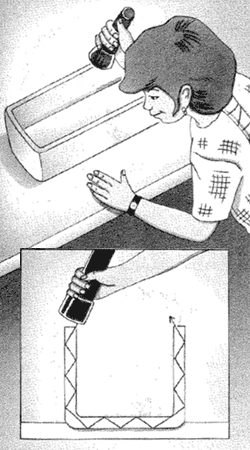Guiding Light
A diamond sparkles because light bounces off the inside of its back surfaces. A diamond is cut so that it has many surfaces at different angles to each other. When the diamond is moved, the back surfaces reflect light to your eyes, and you see them as flashes. This is an example of total internal reflection, or TIR. Diamonds are not the only matter that exhibits TIR. Glass and water also reflect light internally.
Glass optical fibers can make light travel around corners, in circles, through cables across the country, down an esophagus to light up a stomach-to any place we might wish to guide it. Fiber-optic cables can carry far more information than electrical wires and are causing transformation in world communication. In medicine, fiber optics are used to literally shed light on hard-to-see parts of the body. In the next experiment you make light travel around the corner of a baking dish.
Send Light through a Baking Dish

Required Materials
A rectangular clear glass baking dish
A flashlight
A clear glass measuring cup
A bowl of water
Activity Directions
- Place the glass baking dish on a level surface and shine the flashlight down on one rim of the dish.
- Look through the rim of the dish on the side opposite from the flashlight.
- Move the flashlight back and forth along the rim and follow the light that appears on the rim of the other side.
- Hold the measuring cup in one hand while you send the light from the flashlight down through the rim of the cup.
- Put your eyes close to the rim of the cup and look for the light coming up through the glass.
- You will find the emerging light coming up the side opposite the flashlight.
- After you find the light, put the bottom of the cup into the bowl of water.
- See the light dim.
Hereís Whatís Happening
When light crosses a boundary between two transparent substances such as glass and air, it bends away from a line (the normal line) perpendicular to the boundary. As the angle of light hitting the boundary becomes sharper, the light bends farther and farther from the normal line. Finally it reaches an angle (the critical angle) where it no longer exits into the other transparent medium. Instead, at the critical angle, the light is reflected back inside the material itís traveling through. In other words, the light is completely reflected inside the substance and not refracted. The reflection is the total internal reflection (TIR) we mentioned earlier.
Some of the light you shine through the rim of the glass baking dish reaches this critical angle. As the light travels down through the edge into the glass of the dish, some of it hits the boundary between the glass and the air at the critical angle and is reflected back into the glass. Because of the large difference in the index of refraction between glass and air (which means a large difference in the speed of light in each medium) this critical angle is not difficult to achieve. The light is reflected off the glass-air surface back into the baking dish, where it travels until it hits the next glass-air surface. It hits that surface at the same critical angle and reflects internally again. This happens all the way through the glass dish until it exits out the other end, where your eye is waiting to see it. Amazingly, TIR light bends around the corners of the dish.
Total internal reflection also happens with the glass measuring cup. Again, TIR is determined by the difference between glass and air. But when you put the bottom of the cup in water, the situation changes. The difference between the refractive index of water and that of the glass is not as great as the difference between the refractive indexes of air and glass. The critical angle is more difficult to reach. When the light reaches the glass-water surface, the angle is not sharp enough for all the light to bounce off the internal surface. Some of the light passes through the glass into the water, and the remaining TIR light is dramatically reduced.
Hereís how TIR works in fiber optics: Optical fibers are very thin flexible rods of glass (around the thickness of a hair on your head) that are surrounded by another transparent material of much lower refractive index. Since the light travels relatively slowly through the glass fiber and at a much greater speed through the surrounding material, there is perfect opportunity for total internal reflection to take place.
Light is sent into the fiber, and it bounces back and forth inside the fiber all the way to the other end, which is sometimes hundreds of miles away! Pulses of light in a fiber-optic material can carry the same kind of information that is transmitted as electrical pulses in a copper wire. This information can be telephone conversations or data from computers and fax machines. A conventional copper wire can carry a few million electrical pulses each second. But an optical fiber can carry as many as 20 billion light pulses per second! Telephone companies are switching to fiber-optic cables (made of bundles of fiber-optic fibers) because they can handle huge numbers of conversations at one time, many more than conventional copper wire can carry. And fiber optics in computers will vastly increase the amount of information they can handle.
Want to Learn More? Read an article related to this activity:
To find this experiment and many more please read Light Action! Amazing Experiments with Optics by Vicki Cobb and Josh Cobb, illustrated by Theo Cobb. To purchase a copy click here.









